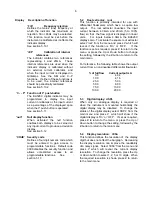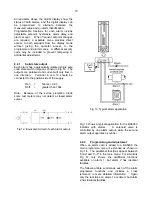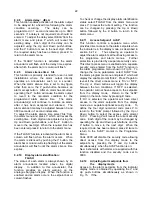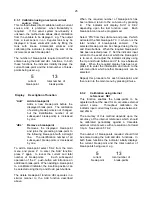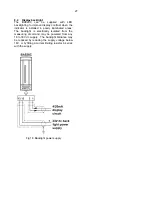
21
'dELA'
Alarm delay
time
Adjusts the delay between the display
equalling the setpoint and the alarm
output being activated.
See section 8.2.8
'SIL'
Alarm silence time
Defines the time that the alarm output
remains in the non-alarm condition
following acceptance of an alarm.
See section 8.2.9
'FLASH' Display alarm identification
Defines if the setpoint bargraph flashes
when an alarm is activated..
See section 8.2.10
'AcSP'
Access setpoint
Sub-menu which enables direct access
to the alarm setpoints from the indicator
display mode, and defines a separate
security code.
See section 8.2.11
8.2.3
Alarm enable: EnbL
This function allows the alarm to be enabled or
disabled without altering any of the alarm
parameters.
To check or change the function
select 'EnbL' from the alarm menu and press
P
which will reveal the current setting. The function
can be changed by pressing the
Up
or
Down
button followed by the
E
button to return to the
alarm menu.
8.2.4
Setpoint adjustment: SP1 and
SP2
The setpoint of each alarm may be positioned
anywhere between -19999 and 19999 (-19990 and
99990 with dummy trailing zero) providing this
corresponds to an input current between 3.8 and
20.2mA. e.g. If the indicator has been calibrated to
display 0 with 4mA input and 10000 with 20mA
input, the two alarm setpoints may be positioned
anywhere between -125 and 10125.
To adjust the setpoint select 'SP1' or 'SP2' from
the alarm menu and press
P
which will reveal the
existing alarm setpoint. Each digit of the setpoint
can be adjusted using the
Up
and
Down
push-
buttons, and the
P
button to move to the next digit.
When the required setpoint has been entered
press
E
to return to the alarm menu.
8.2.5
Alarm function: HI.LO
Each alarm can be conditioned as a high or low
alarm.
To check or change the alarm function
select 'HI.LO' from the alarm menu and press
P
to
reveal the current setting. The function can be
changed by pressing the
Up
or
Down
buttons
followed by the
E
button to return to the alarm
menu.
8.2.6
Alarm output status: no.nc
This function allows the alarm output to be open or
closed in the alarm condition.
When deciding
which is required, care must be taken to ensure
that the alarm output is fail safe.
See Fig 10.
CAUTION
When the 4/20mA supply is removed
both
alarm
outputs
will
open
irrespective
of
conditioning.
Therefore for fail safe operation both
alarm
outputs
should
be
programmed to be open in the alarm
condition.
To check or change the alarm output status select
'no.nc' from the alarm menu and press
P
reveal the
current setting. The function can be changed by
pressing the
Up
or
Down
button followed by the
E
button to return to the alarm menu.
8.2.7
Hysteresis: HStr
During programming hysteresis is shown in the
units the indicator has been calibrated to display.
To adjust the hysteresis, select 'HStr' from the
alarm menu and press
P
which will reveal the
existing figure. Each digit can be adjusted using
the
Up
and
Down
push-buttons, and the
P
button
to move to the next digit.
When the required
hysteresis has been entered, press
E
to return to
the alarm menu.
e.g. An indicator calibrated to display 0 to 10000,
with a high alarm set at 9000 and hysteresis of 200
will perform as follows:
High alarm will be activated when display
equals or exceeds 9000, but will not reset
until the display falls below 8800.
Содержание BA526C
Страница 11: ...11 ...


